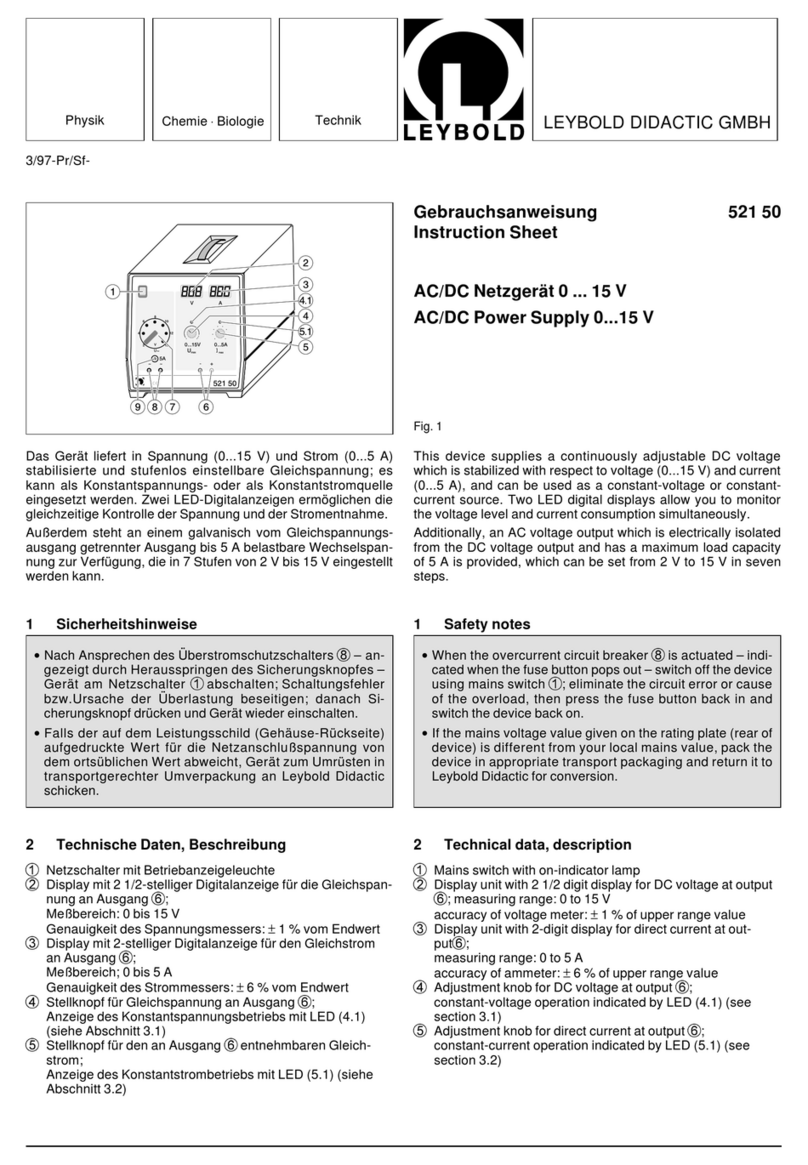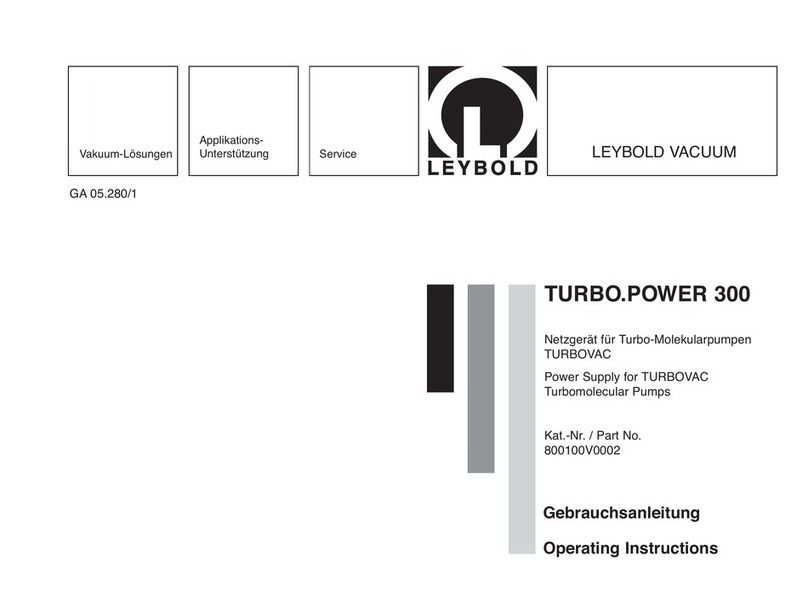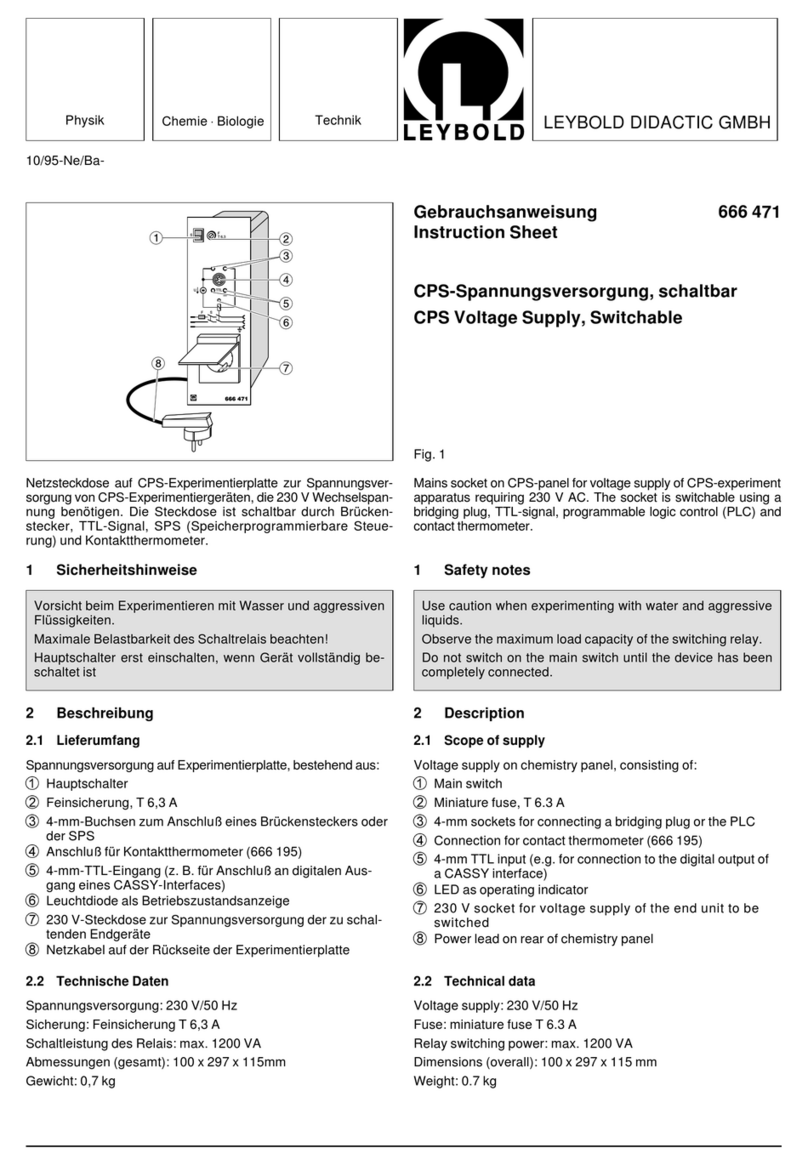
9
Pushbutton for activating/deactivating triangular wave-
form mode;
operational readiness indicated by LED (9.1);
set value displayed on scale (8.1)
- 0.2 A/s scale division
- Reading accuracy: 10 % of set value
Appliance-plug connector with integrated holder for primary
and spare fuse on rear of device.
Mains connection cable included in scope of supply.
Two folding feet in bottom of housing for inclining the device.
Additional technical data
Protection:
- Primary side: Fuse
see fuse rating plate above on rear of de-
vice.
- Secondary side: electronic temperature monitoring auto-
matically cuts out current in the event of
thermal overload which can damage the
electronic components of the device.
Interruption of current indicated when indi-
cated when LEDs (4.1), (5.1) and
7
light
up, as well as by the two displays drop-
ping to zero
Mains voltage 230 V AC; 50/60 Hz or 115 V AC
(according to rating plate on rear
of device)
Power consumption: 450 VA
Dimensions: 20 cm x 21 cm x 23 cm
Weight: 3.0 kg
3Operation
3.1 Using the device as a constant-voltage source
Set the current-limiting knob
5
to the maximum position (full
right deflection). LED (4.1) lights up, indicating that the device is
operating in constant-voltage mode. Set the desired voltage
value using knob
4
(the value appears in display
2
).
Option:
If you also want to limit the maximum current consumption to
values below 20 A in order to protect the connected apparatus,
disconnect the power supply from the circuit, short output
6
(e.g. using a bridging plug) and turn the current-limiting knob
5
down until the desired maximum current is flowing (indicated by
display 3
and LED (5.1)). Then reduce the voltage to zero with
knob
4
, remove the short-circuit and reconnect output
6
to the
circuit.
Now, when you increase the voltage with knob
2
, no current
greater than the set limit value can flow regardless of the con-
nected load. When current limiting is activated, LED (5.1) lights
up, and it is not possible to increase the voltage further with
knob
4
.
3.2 Using the device as a constant-current source
Set the voltage-limiting knob
4
to the maximum position (full
right deflection). LED (5.1) lights up, indicating that the device is
operating in constant-current mode. Set the desired current va-
lue using knob
5
; the value appears in display
3
.
Option:
If you also want to limit the maximum voltage to values below
24 V in order to protect the connected apparatus, make sure
output
6
is open and turn the voltage-limiting knob
4
down
until the desired maximum voltage is present (display
2
and
LED (4.1)). Then reduce the current to zero with knob
4
and
connect output
6
to the circuit.
9
Taster zum Ein- bzw. Ausschalten der Dreieckstrom-
Modus;
Anzeige der Funktionsbereitschaft durch LED (9.1)
Anzeige des eingestellten Wertes auf Skala 8.1
- 0,2-A/s-Teilung
- Ablesegenauigkeit: ±10 % vom eingestellten Wert
Auf der Gehäuse-Rückseite Steckerwanne mit integriertem Si-
cherungshalter für Primär- und Reservesicherung.
Netzanschlußkabel im Lieferumfang enthalten.
Im Gehäuse-Boden 2 ausklappbare Füße zum Neigen des Ge-
rätes.
Weitere technische Daten
Sicherungen:
- Primärseite: Schmelzsicherung
Wert siehe Sicherungsschild auf der Ge-
häuse-Rückseite
- Sekundärseite: elektronische Temperaturüberwachung
zur automatischen Verhinderung der Stro-
mentnahme bei thermischer Überlastung,
durch die die Elektronik des Gerätes
Schaden nehmen kann;
Anzeige der Stromunterbrechung durch
Aufleuchten der LEDs (4.1), (5.1) und
7
sowie durch Null-Anzeige in beiden Dis-
plays
Netzanschlußspannung 230 V
"
; 50/60 Hz bzw. 115 V
"
(gemäß Leistungsschild auf der
Gehäuse-Rückseite)
Leistungsaufnahme: 450 VA
Abmessungen: 20 cm x 21 cm x 23 cm
Masse: 3,0 kg
3 Bedienung
3.1 Betrieb als Konstantspannungsquelle
Stellknopf
5
für die Strombegrenzung auf Maximum (Rechts-
anschlag)l stellen. Die LED (4.1) für Konstantspannungsbetrieb
leuchtet auf. Durch Betätigen des Stellknopfes
4
den ge-
wünschten Spannungswert einstellen (Anzeige in Display
2
).
Option
:
Soll zusätzlich der maximal entnehmbare Strom zum Schutz
der angeschlossenen Geräte auf Werte unter 20 A begrenzt
werden, so ist nun ohne angeschlossene Schaltung bei kurz-
geschlossenem Ausgang
6
(z.B. mittels Brückenstecker) der
Stellknopf
5
für die Strombegrenzung soweit zurückzudrehen,
bis der gewünschte Maximalstrom fließt (Anzeige im Display
3
sowie durch LED (5.1)). Sodann die Spannung mit Stellknopf
4
wieder auf Null zurückdrehen, den Kurzschluß entfernen und
Ausgang
6
mit der Schaltung verbinden.
Bei Erhöhen der Spannung mit Stellknopf
2
kann nun, unab-
hängig vom angeschlossenen Verbraucher, kein Strom ent-
nommen werden, der größer als der eingestellte Maximalwert
ist. Mit einsetzender Strombegrenzung leuchtet die LED (5.1)
auf, und eine weitere Erhöhung der Spannung mit dem Stell-
knopf
4
ist nicht möglich.
3.2 Betrieb als Konstantstromquelle
Stellknopf
4
für die Spannungsbegrenzung auf Maximum
(Rechtsanschlag) stellen. Die LED (5.1) für Konstantstrombe-
trieb leuchtet auf. Durch Betätigen des Stellknopfes
5
den ge-
wünschten Strom einstellen (Anzeige im Display
3
).
Option
:
Soll zusätzlich die maximal einstellbare Spannung zum Schutz
der angeschlossenen Geräte auf Werte unter 24 V begrenzt
werden, so ist bei offenem Ausgang
6
der Stellknopf
4
für die
Spannungsbegrenzung soweit zurückzudrehen, bis die ge-
wünschte Maximalspannung erreicht ist (Display
2
sowie LED
(4.1)). Sodann den Strom mit Stellknopf
4
wieder auf Null zu-
3



























